
Material Considerations
Now you’re ready to choose what your ideal fire pit table is made of. If you landed on a permanent fixture, your decision is narrowed to the materials used to construct your patio, deck or other architectural elements you want to blend with. Freestanding fire features, on the other hand, open you up to a world of possibilities, each with plusses and minuses. Also, the tabletop and base materials don’t necessarily have to be the same and often aren’t.
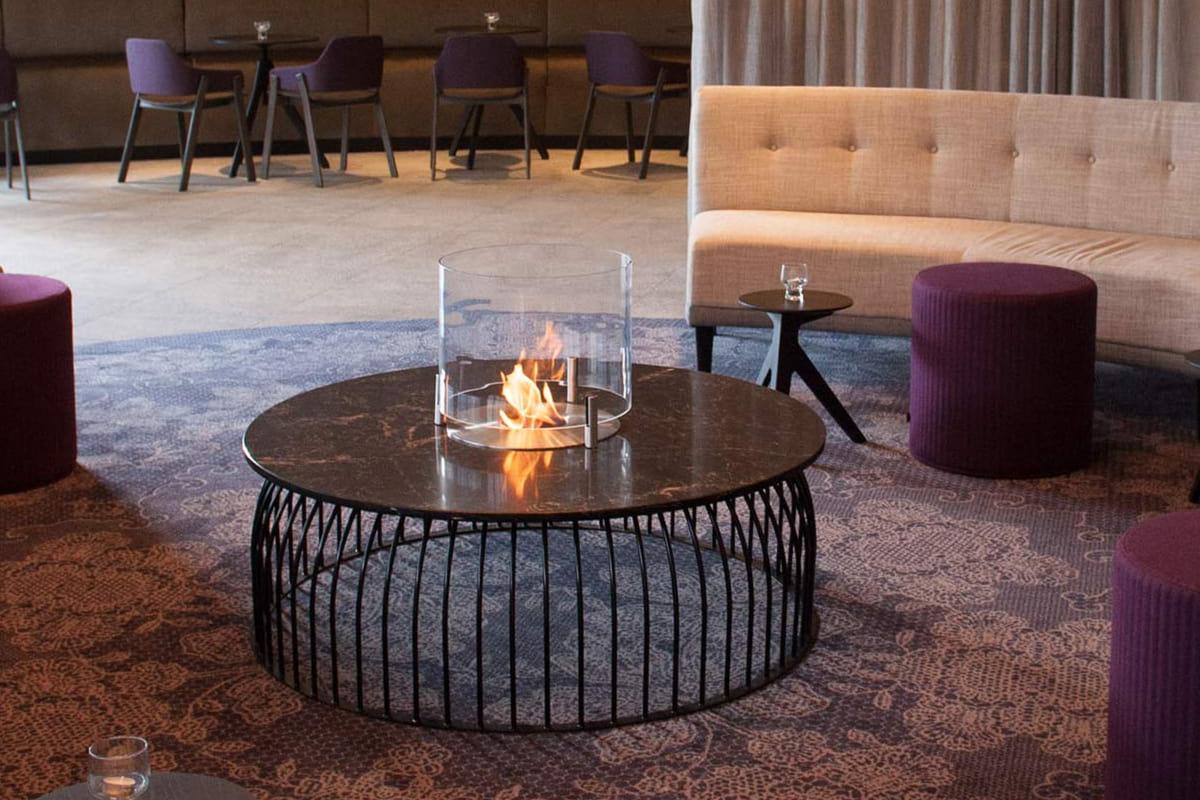
When making your material selection, consider the weather conditions of your area and the aesthetic ambiance you plan on creating. Extreme heat or cold, dramatic temperature shifts and precipitation affect the performance and longevity of different materials. But how a fire table looks and feels is important too. While you might not want one to stick out like a sore thumb, creating an eye-catching focal point is an option. Materials can reinforce or contrast with your existing palette and outdoor decor style.
Another important consideration when selecting the material is its heat conductivity. Fire pit tables need to dissipate heat efficiently; otherwise, they could break or become dangerous. Unlike traditional fire pits where people are hands off, tabletop fires are intended to be interacted with – reaching for drinks, eating food or setting small items. This shouldn’t be a major concern for manufactured models required to pass safety tests before going to market. However, if you’re attempting an adventurous DIY project, be keenly aware of how materials dissipate or absorb heat. Many fire tables use one material for the top surface that comes in contact with the heating area (as well as hands and arms) and another for the base or pedestal.
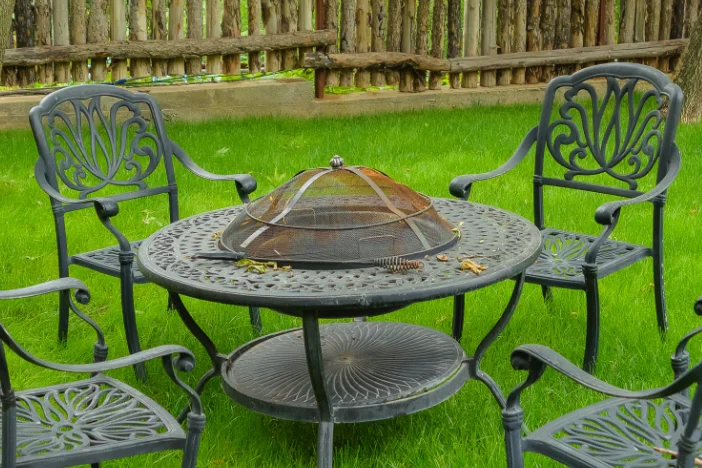
Metallic Options
Since metal absorbs and conducts heat (i.e. it gets hot and will burn you), it’s only used on the top for cooking (i.e. convertible grill) or areas away from the fire. These may be accents or banding around the tabletop but metal is also used for the framework beneath it. Most metals are durable, can be shaped easily and are relatively weather-resistant with varying degrees of vulnerability to corrosion.
Stainless Steel
This metal is stronger but also more expensive than other options. Stainless steel includes Nickel and Chromium, which can improve its resistance to rusting even in harsh marine environments. In its raw form, it has a shiny silvery finish. However, a powder coating is often applied to improve stainless steel’s durability and complement existing patio furnishings. It’s also easy to maintain, although “tea staining” may occur if not cleaned regularly.
Cast Iron
If you want a heavy-duty metal base, then cast iron is a great choice. It’s extremely heavy, so even if it’s technically freestanding, a firepit table sitting on a cast iron frame isn’t going anywhere. This relatively inexpensive black metal resists corrosion but will discolor when exposed to moisture and left untreated.
Aluminum
This lightweight rust-resistant metal is affordable but can get scratched or dented easily. Be sure the tabletop is heavy or bolt the frame to the flooring to ensure the fire table can’t get knocked over. Naturally silver aluminum often has a stylish “hairline” finish or a powder-coating to enhance its corrosion resistance, improve its durability and coordinate with outdoor palettes.
Bronze
This copper-based alloy has a rustic appearance and has some corrosion-resistant properties. Due to the presence of copper, however, it oxidizes and changes color from dark reddish brown to a shade of green. Its surface can be hammered for a more industrial look but bronze is a handsome metal that tends to complement several design styles. Bronze finishes are common on the metal frames of patio furniture and umbrellas.
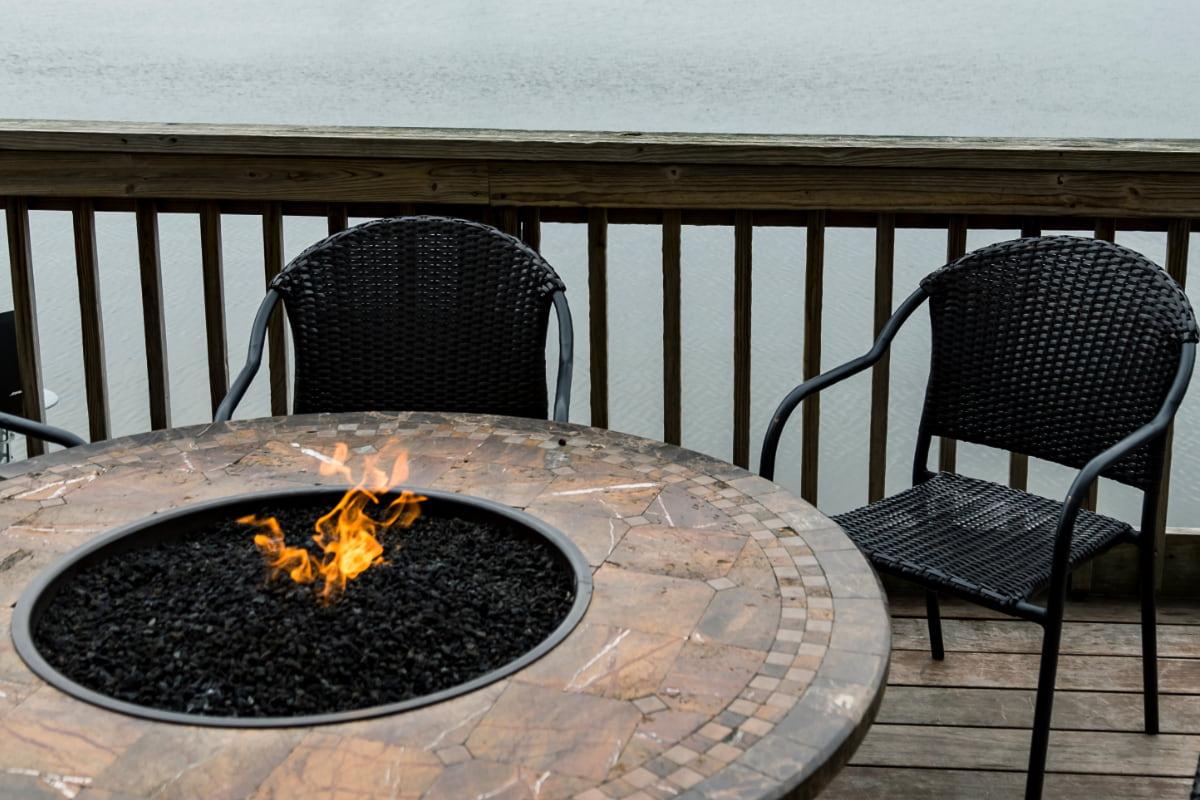
Mineral Choices
Many common mineral substances are relatively heat-resistant and make excellent bases and tops for firepit tables. They are very sturdy and have a rugged natural appearance. Their heavy weight is a benefit for stability but a problem if you’re hoping for mobility.
Marble & Granite
These natural stones are heat-resistant and long-lasting. Even when containing a roaring fire, these minerals remain relatively cool to the touch. Unlike cast or extruded metal, each granite or marble slab has a unique grain that varies from piece to piece. So, even the same style of fire table will look different. A tiled marble top adds additional texture and visual appeal.
Concrete
This poured mineral mix of sand, gravel and cement can be cast in virtually any shape, making it a great option for firepit tables. It’s a natural heat insulator so it’s extremely safe and durable. Concrete fire tables have a minimalist look that goes well with modern or rustic settings. One drawback of concrete is that it will accumulate soot stains over time and must be cleaned and sealed periodically.
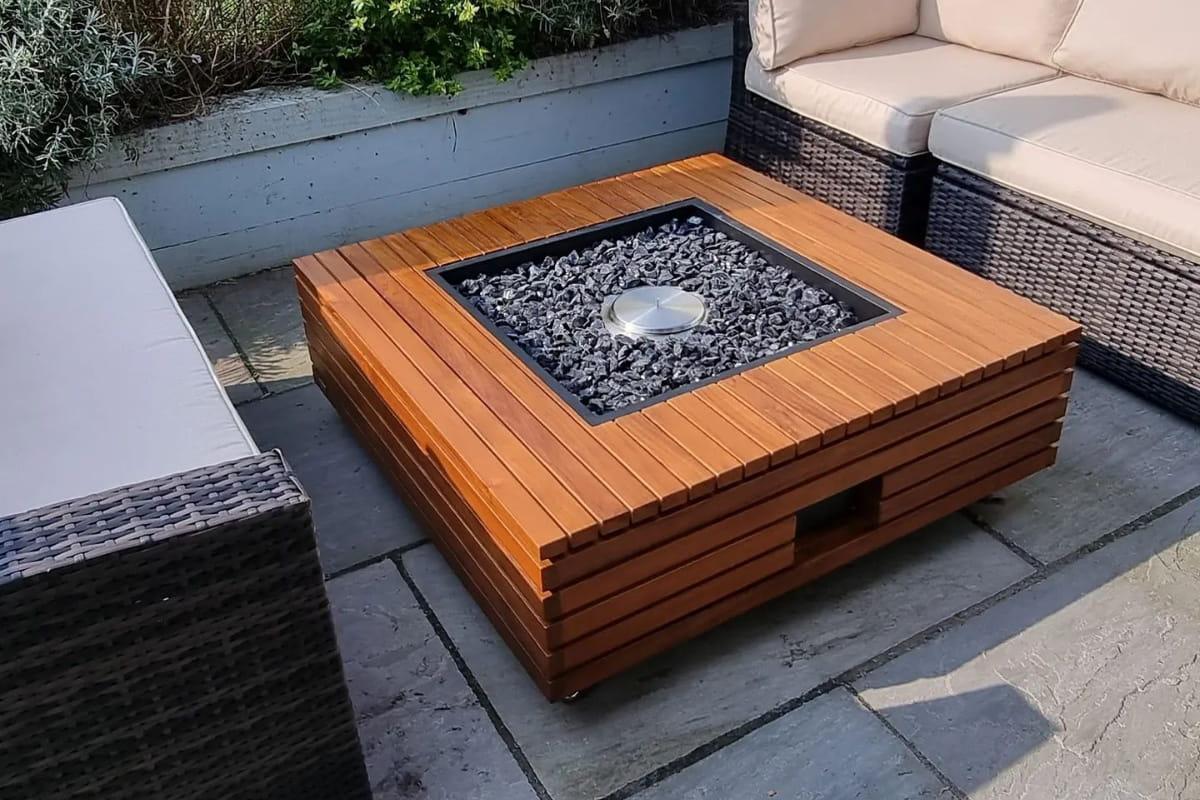
Wooden You Know It
Although it may sound strange, some firepit tables are made of wood. Most of the time, the lower frame or pedestal is the component that is constructed using hardwood with a non-conductive tabletop around the flame area. However, there are teak fire pit tables that use wood throughout. The woodgrain adds natural beauty and has a welcoming feel. Because the wood is lighter, these fire features often have metal interior structures with the wood as an aesthetic facade. While teak is oil-rich and very weather-resistant, it requires ongoing maintenance to retain its honey color and prevent heat damage.
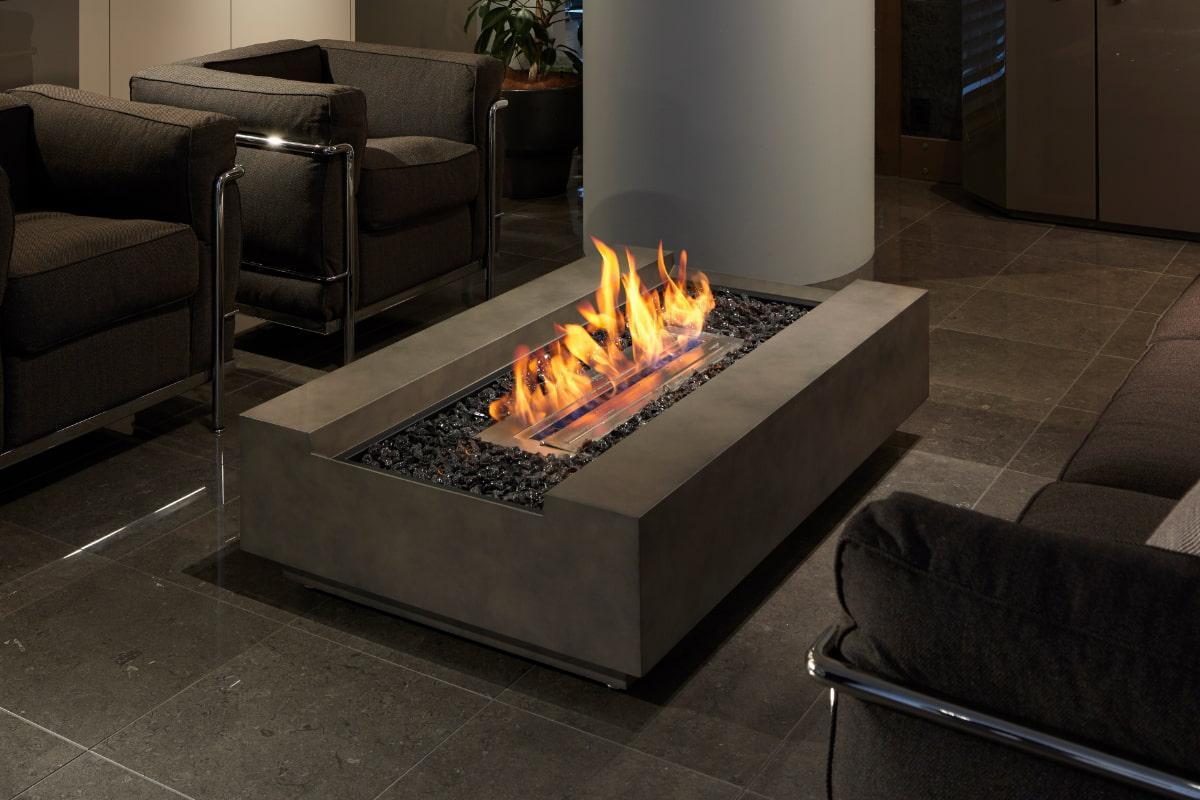
Synthetic Material Alternatives
In addition to natural options, there are also a few man-made substances that can work well for firepit tables. Improved strength, lighter weight and greater design capabilities give these synthetic materials advantages over Mother Nature’s offerings.
Faux Concrete
Concrete composites have been developed and improved upon in response to the growing demand for outdoor furnishings with non-traditional shapes. These polymer concretes utilize cement, resin and fiberglass to create customizable compounds that mimic concrete but with more advantageous properties. Blinde Design’s Fluid™ Concrete has a tensile strength 8 times that of regular concrete and weighs less. Equally as important, it’s non-porous, so it resists scratches, impact, stains and cracking due to dramatic temperature changes. So, you can get the look and feel of stone or concrete in multiple colors and still be able to move fiber concrete fire tables.
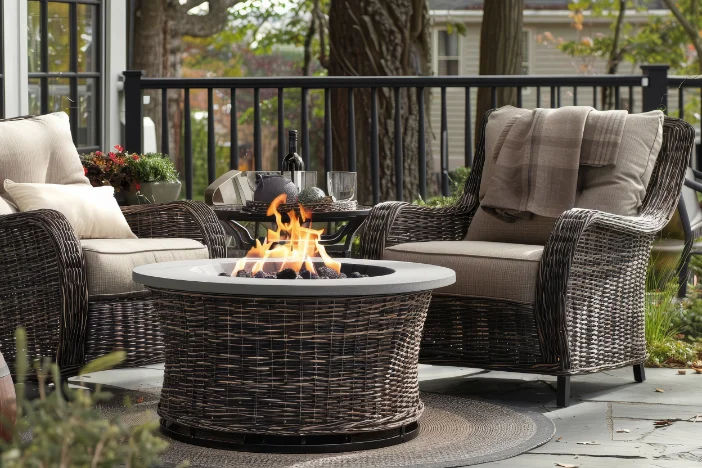
All-Weather Wicker
Another option for fire table bodies is long-lasting synthetic wicker. This fade-resistant woven material is made from HDPE or another durable plastic resin. Lower quality PVC-based wickers are also available but they crack over time. Synthetic wickers come in natural colors or vibrant ones. Due to its lighter weight, it’s usually wrapped around a metal frame. All-weather wicker fire pit tables have a homespun look that can work well in traditional outdoor settings or even more modern ones, depending on the style of the table’s construction and the type of weave. However, resin wicker tends to be expensive and harder to clean and fix, should it become damaged.
The right material for your fire pit table
Choosing the most appropriate material for your fire table will save you a lot of aggravation if done properly. If you carefully consider the requirements of your environment and expected use, the right material will last and look great for years. Now that the blocking and tackling is done, you can focus on more aesthetic qualities – the design. The next section of our in-depth guide covers some of the main design considerations: shape, height and style.

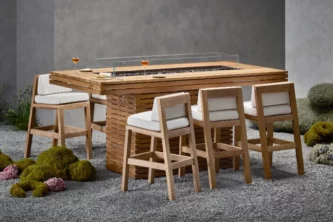


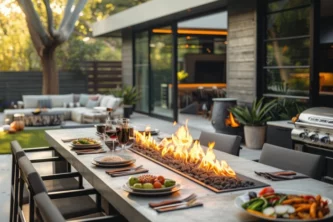
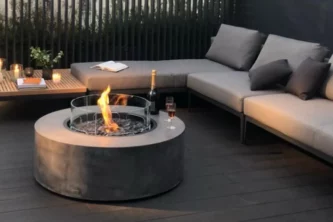




Leave a Reply